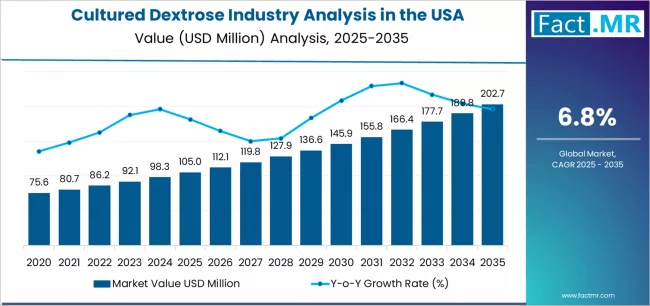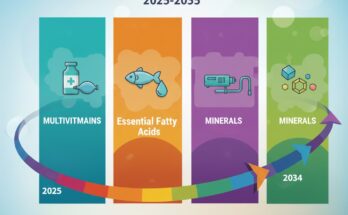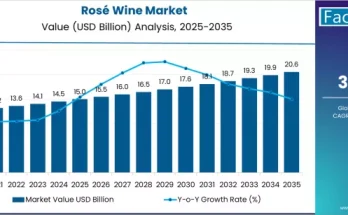The United States cultured dextrose industry is set for consistent growth throughout the next decade, propelled by increasing consumer preference for clean-label food, natural ingredient adoption, and the rising need for safer alternatives to synthetic preservatives. A recent industry assessment from Fact.MR reveals that U.S. demand for cultured dextrose is expected to advance from USD 105.0 million in 2025 to USD 205.0 million by 2035, reflecting an absolute market expansion of USD 100.0 million over the forecast period. This marks a strong CAGR of 6.8% from 2025–2035.
Cultured dextrose, recognized for its ability to inhibit microbial growth while maintaining product quality, is rapidly gaining trajectory across food, beverage, and processed product applications, as manufacturers pivot toward transparency and ingredient simplification.
Key Market Drivers
Clean-Label Movement Drives Industry Momentum
Growing demand for minimally processed food with recognizable labels is one of the primary forces shaping ingredient reformulation in the U.S. Cultured dextrose offers an effective natural formulation solution, delivering both safety and label appeal without impacting taste or texture.
Natural Preservative Segment Strengthens Market Demand
The natural preservative category is estimated to represent 56.0% of U.S. cultured dextrose demand in 2025, positioning it as the dominant segment nationwide. Food producers are increasingly integrating cultured dextrose into baked goods, dairy, dressings, meat alternatives, sauces, and snacks to extend shelf life using non-chemical methods.
Processed Food & Convenience Segment Expansion
Fast-paced lifestyles and increased consumption of refrigerated and ready-to-eat products are encouraging manufacturers to adopt natural solutions that prevent spoilage, making cultured dextrose a key pillar in modern food stabilization strategies.
Ingredient Innovation & Enhanced Fermentation Techniques
Ongoing improvements in fermentation processes, ingredient refinement, and product functionality are helping suppliers boost scalability, improve stability performance, and respond to evolving regulatory and consumer expectations.
Browse Full Report: https://www.factmr.com/report/united-states-cultured-dextrose-industry-analysis
Regional and Retail Market Context
The U.S. remains one of the most progressive markets globally in adopting natural and fermented preservation solutions, supported by high awareness of ingredient safety, strong retail infrastructure, and widening availability of clean-ingredient packaged and fresh foods.
The ingredient is gaining strong distribution channels across:
- Supermarkets & hypermarkets
- Online retail platforms
- Food processing and ingredient suppliers
- Commercial bakery and dairy producers
Market Segmentation Overview
By Category
- Natural Preservative Segment – Leading adoption, projected at 56.0% share in 2025
- Clean-Label Food Stabilizers & Functional Additives – Increasing penetration
By Application
- Bakery & Confectionery
- Dairy & Frozen Desserts
- Sauces, Dressings & Dips
- Meat & Plant-Based Alternatives
- Ready-to-Eat & Refrigerated Packaged Foods
Challenges Affecting Market Growth
Higher Cost Compared to Synthetic Alternatives
Natural fermentation-derived ingredients often involve higher production costs than conventional chemical preservatives, posing challenges for budget-driven product categories.
Awareness in Smaller Food Processing Units
While large food manufacturers are driving wide adoption, smaller and regional processors are still transitioning to natural alternatives, which may slow early-stage penetration.
Competitive Landscape
The U.S. cultured dextrose market continues to grow steadily with suppliers prioritizing:
- Scalable fermentation technology
- Clean-label compliant preservation systems
- Flavor-neutral preservation performance
- Partnerships with food manufacturers
- Product innovation targeting refrigerated and natural food lines
Recent Industry Trends
- Increased clean-ingredient reformulation in processed and refrigerated foods
- Growing adoption in dairy and bakery product stabilization
- Retail expansion of naturally preserved packaged foods across commercial channels
Future Outlook
Over the next ten years, the U.S. cultured dextrose industry is expected to evolve through:
- Broader adoption of natural preservatives
- Growth in frozen, chilled, and convenience food segments
- Advancements in controlled fermentation systems
- Increased shift away from chemical additive usage
As U.S. consumers continue to seek safer, recognizable, and sustainable food preservation ingredients, cultured dextrose is positioned to remain a leading natural solution for long-term product stability and clean labeling.



